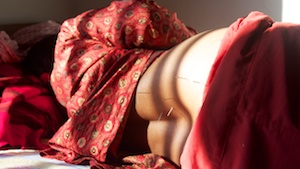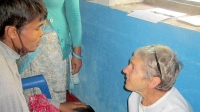Sarah Martin MAcOM LAc
November 2012
OVERVIEW
 36-year-old female with lumbar spinal stenosis presents with severe low back pain with referred pain down the posterior left leg and anterior right thigh. The patient lives several hours from the clinic, but was able to stay in Kathmandu temporarily in order to get daily treatment for 2 weeks. After 12 treatments, the patient reported 80% of her pain relieved for a sustained period of 4 days, after which the pain started to slowly return.
36-year-old female with lumbar spinal stenosis presents with severe low back pain with referred pain down the posterior left leg and anterior right thigh. The patient lives several hours from the clinic, but was able to stay in Kathmandu temporarily in order to get daily treatment for 2 weeks. After 12 treatments, the patient reported 80% of her pain relieved for a sustained period of 4 days, after which the pain started to slowly return.
SUBJECTIVE
The patient presents with severe low back pain with referred pain down the posterior left leg and anterior right thigh. The pain interferes with her ability to walk without limping. The issue had a gradual onset beginning 3 years ago, continually getting worse, and within the last year it has increased to severe pain. Nothing helps the pain and the patient reports that it is made worse by bending, straightening, twisting, standing, walking and sitting too long. The patient describes her pain as severe, with a sharp burning quality running from the left PSIS area down the posterior portion of the thigh to the middle of the posterior calf and down both the anteromedial and anterolateral portion of the thigh just above the patella. The patient rates her pain as intolerable and constant. No muscle weakness or stiffness are reported. Due to the cost of recommended surgery, the patient hopes acupuncture can help her avoid surgery and perhaps slow the long-term progression of the arthritis.
OBJECTIVE
The patient received an MRI, which showed compressed nerves due to the narrowing of disc space between lumbar vertebras 4 and 5. She was informed that the disc space is narrowing due to arthritis of the spine and surgery is necessary to scrape the bone away from her nerve.
The patient reports no use of any prescription medications or OTC pain relievers.
Patient appears to be in good health, besides dealing with severe pain. Because of pain, the patient appears to be severely distracted, however can answer questions competently. The patient walks with a limp in her left leg. She is unable to sit up without assistance after laying down for the treatment due to the severity of her pain, rather than weakness. All transitions between positions - sitting, lying, standing - are strained and painful.
The Valsava test is positive with severe pain referring down the posterior left leg and anterior right thigh.
Palpation shows no significant findings on her lumbar spine, but shows her pain starting at L3 to under L5 and surrounding the posterior superior iliac spine (PSIS) and down into the sacral foramen, especially S2. Her right PSIS is more proximal than the left and tension is found in the right piriformis. Palpation down the left posterior thigh shows pain directly down the Bladder meridian to BL57 and palpation at the right anterior thigh shows the pain running along both Spleen and Stomach meridians to SP10 and ST34 region.
Patient shows no signs of muscular atrophy. Difficulty in walking is due to pain, rather than weakness.
Her blood pressure and heart rate are within normal limits at 113/84 and pulse 72 b/m.
ASSESSMENT
DX: Lumbar spinal stenosis with narrowed disc space between L4 and L5. Possible subluxation of the sacral iliac joint. Due to her age, it is hypothesized that she has the congenital form of lumbar spinal stenosis.
Medical recommendations from hospital: It is likely that the doctor at the hospital is recommending a laminectomy, foraminotomy or a nerve block.
TCM DX: Bone bi syndrome with qi and blood stagnation in the Bladder, Governing Vessel, Stomach and Spleen meridians with underlying Kidney essence deficiency and Liver blood deficiency.
PROGNOSIS: Due to the severity of the condition and the nature of lumbar spinal stenosis, the prognosis is fair with regular treatments. The patient is young. In the long-run, treating with just acupuncture and herbs leads to a likely poor prognosis. These modalities may delay surgery, but chances are, will not eliminate the need for it.
INITIAL PLAN
Treat with acupuncture daily for 7 treatments and then reassess. The treatments focus on breaking up qi and blood stagnation in the Governing Vessel, Bladder, Stomach and Spleen Meridians with electro-acupuncture as the main modality. Internal herbal treatment includes Huo Luo Xiao Ling Wan and Xiao Huo Luo Dan Wan. These formulas are used to break up blood stasis, open the collaterals and move qi and blood to stop pain.
Typical treatment: Left: SI3, ashi BL57; Right: BL62, LI4, GB21; Bilateral: HTJJ L3 – L5, Shi Qi Zhui Xia, ashi PSIS area, BL32 – 34, GB30, Huan Zhong , BL40, BL60. Electro from left HTJJ L5 to left BL60, right ashi PSIS to right BL60 and bilateral BL32 to BL40, 5/100 Htz milliamp with mixed frequency. Pain patches and ear seeds are utilized to increase the effects of treatment outside the treatment room. Salonpas pain patches with camphor and menthol to provide a cooling analgesic effect and ear seeds on lumbar spine and sciatic points are also given at the end of each treatment.
Alternate treatments: Right: ST34 and ST41 for right thigh pain, superficial transverse needling with manual stimulation of ashi points surrounding the PSIS for sacral realignment.
OUTCOME
Due to the circumstance of the patient living several hours from the clinic, daily treatments were given for the first 12 visits. On the 12th treatment, the patient reported 80% of her pain was relieved and tolerable. Bending, straightening, twisting and walking no longer caused her pain. Furthermore, she no longer needed assistance in getting up from the prone position. The patient could walk without a limp. The 13th treatment was spread out to 5 days later to observe if the pain relief could be sustained. On the 13th treatment, the Valsava test indicated considerable treatment results with moderate pain only at BL32, rather than severe sharp, burning pain radiating down the posterior left leg and anterior right thigh as seen on the first visit. It was reported at this visit that 80% pain relief was sustained for 4 days after the 12th treatment, at which time the pain began to return slightly. However, she felt enough pain relief to return home to spend the Dosain holiday with her family and start work for the harvest season. The outcome was better than I, the practitioner, initially expected. Perhaps the MD’s assessment for surgery was premature and the original prognosis was understated. With continued acupuncture and herbal treatment, the inflammation and pain could be reduced long-term and the degenerative nature of the disease might be slowed.
CONCLUSION
Due to the inflammatory process and degenerative nature of lumbar spinal stenosis, regular acupuncture and herbal treatment might be the best option for long-term pain relief and slowing the progression of her arthritis. The patient was informed that regular acupuncture and massage treatment might be the only alternative to surgery. Due to the logistics of living so far from the clinic, if her pain returned or worsened, surgery might be her only option for sustainable pain relief.











